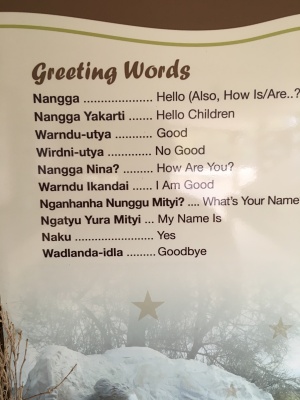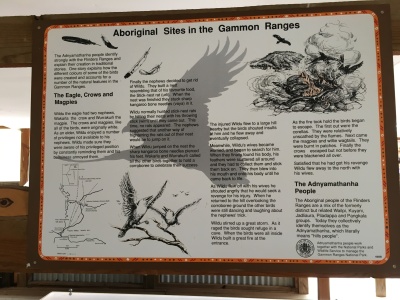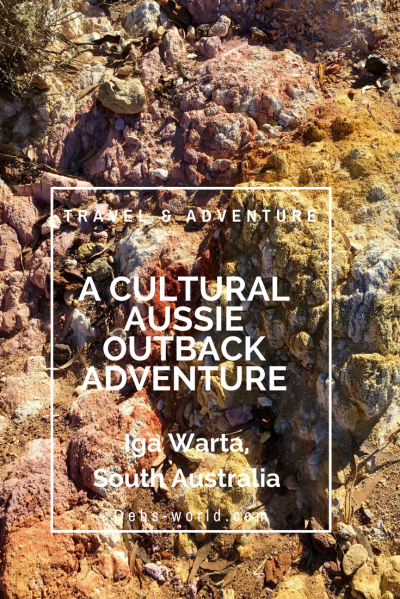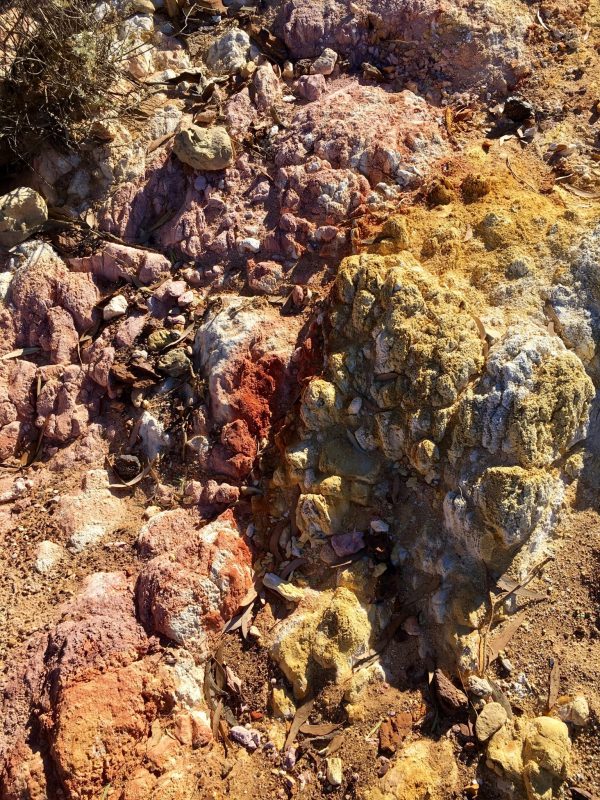Welcome to Iga Warta – Day 3 full of culture and history
Nangga (pronounced nunga) means hello/welcome in the local Adnyamathanha (pronounced Udna-mat-na) language. We are learning lots of words for plants, animals and birds, as we go on our walks with guides Sharpie, Cliff and Terry. It’s been very enlightening and educational not to mention interesting. The good news is their language is alive and well and still spoken in households today as well as taught in schools in the area.

Today was a rest day from walking, but although not a physical day, it was still a tough day in some regards. This was due to hearing about their history, the impact of the arrival of Europeans and many cultural issues that affect the local people.
It was a very cool day with a freezing wind blowing us about as we boarded the minibus for our cultural tour with Cliff as our guide. We visited Mt Serle, which was the first meeting point of white man with the local people back in late 1830s. Cliff told us the dreamtime story of the eagle, the crow and the magpie which is part of their muda (the Adnyamathanha word for dreamtime).
Here’s the story:

We saw a plaque to honour the last fully initiated elder back in 1948, as after this date the missionaries had come in and initiations became a thing of the past. We visited Minerawuta, also called Ram Paddock Gate, where the Adnyamathanha people were moved to from Mt Serle, before they moved to the ‘Promised Land’ of Nepabunna mission.
We heard lots of stories about wonderful characters including one missionary John Page and another white woman, Rebecca Carsaldine, who married a local man and helped keep many alive after outbreaks of whooping cough circulated throughout the camps.
Nepabunna is still operating as a little town with many of the locals still living there. Throughout our drive around Cliff pointed out quandong trees, and the native orange tree called Iga, which is where Iga Warta gets its name from. It was a great morning of social history and culture.
The ochre pits
After lunch back at Iga Warta, we continued on our tour with a moving visit to the Ochre pits. Ochre was a major trading item for the local people and we enjoyed hearing how they carried the ochre wrapped up in their hair, to enable their hands to be kept free for hunting. The hair protected the ochre in some ways too.
On the way, Terry stopped at a huge old tree and reiterated the meaning of life as seen by the Adnyamathanha people – connection to Mother Earth, respect, caring, sharing and above all else love. The branches and leaves supports animals, covers the land, allows replenishment and earth as the giver of life. Values we could all do well to remember in this crazy world we live in today.
The ochre pits were huge and looked like they’d been dug into by a machine but it’s been used for thousands of years by the locals to trade with other nations.
Terry dug into the ground for the different colours of ochre, telling us their meaning and daubing us all in the process. White was for the spirit world, yellow was for a renewal, red for the blood of the earth, brown for Mother Earth and breathing and purple to cleanse and reboot. Each colour was dotted onto our faces, forehead and neck in an almost spiritual way. In fact, it was almost like a blessing as he did so, with the addition of each colour he asked us individually if we were ready to connect to the earth, take charge of our lives, reboot, accept the spirit world…and so on. Afterwards we joined a circle around a little fire, held hands as Terry summed up our experiences, asking each of us in turn what we would be taking away from the visit. It was emotional, moving and beautiful. Terry is an exceptional storyteller and poet.
The Aboriginal Australian Rules footballer, Adam Goodes, was featured recently coming back to his country to take part in this ceremony and was very emotional about his experience, as it really affected him, and I can now see why.
We proudly kept the ochre on our faces as long as we could and must have looked a bit fearsome to some some visitors later in the day, who didn’t stay very long after seeing us all with our painted faces!!
We are having a fabulous experience! It is an adventure way more than I ever hoped it would be. I hope you are enjoying it as much as I am.

Day 1 of walking can be found here – An Aussie Outback Adventure #1
Day 2 of walking can be found here – An Aussie Outback Adventure #2
Stay tuned for more updates!!
Deb
You can also find Deb’s World here – I’d be delighted if you’d join me.













Hi Deb I’ve chosen your post as my feature for this week’s Over the Moon Link Party. Hope you link up next week. Have a great weekend.
LikeLiked by 1 person
Thanks so much Sue! I’m thrilled 😁
LikeLiked by 1 person
Oh I’m happy to hear that! Have a great weekend. xx
LikeLiked by 1 person
What a fantastic adventure Deb. Love the cultural aspect of this, there’s so much to learn out there. We visited the Ochre pits in the West Mac ranges which was such an amazing landscape (no painting for us though). Great post. x
LikeLiked by 1 person
I’m so enjoying reading your travels Debbie and I didn’t realise ochre came in different colours. The outback is certainly a very spiritual place and definitely on my list to visit. I think it would be magical. Thanks for sharing your journey with us at #overthemoon link party. Continue with your wonderful travels. xx
LikeLiked by 1 person
I was surprised at the different ochre colours too, especially the lavender one but it was just lying on the ground. It really was a spiritual experience.
LikeLike
Good to hear their language is alive and well. I didn’t know you could get lavender coloured ochre. Love the face paint. Louise
LikeLiked by 1 person
Hi Louise!! It was a real insight learning so much about language and culture while we were there. The lavender was gorgeous and just lying around in the ochre pit. Glad you like the face painting, it was great fun.
LikeLiked by 1 person
What wonderful wisdom to share and experience. Mankind sure needs it right now. I love the idea of the ochre ceremony. Beautifully written . Thank you.
LikeLiked by 1 person
Thank you for your lovely comment. It was a great experience and you are right, we could all do with it right now! Their care, share and respect message is very relevant today. I’m so glad you enjoyed reading my post and left me a comment to say so 😊
LikeLiked by 1 person
Thank you for sharing this indigenous history and culture. I find it fascinating and am currently reading Stan Grant’s ” Talking to my country”.
LikeLiked by 1 person
That’s a great read isn’t it? Thanks Ruth. It certainly is a fascinating adventure and I’m learning so much along the way.
LikeLiked by 1 person
Wow. Sounds like a very moving experience.
LikeLiked by 1 person
Yes it was just that Jennifer and their message is spot on. Thanks for the comment and visit.
LikeLike
What a great adventure filled with such rich history, language and culture. Thanks for sharing this and including us on your journey!
LikeLiked by 1 person
Thanks for joining me on my adventure Donna. I’ve loved reading your posts too.
LikeLike
I love this Deb, it so wonderful to know the language and the stories live on with these amazing people. We do not have much to be proud of when it comes to how Aboriginal/ Original
people from other countries have been treated in history. This post bring great hope for their future.💜💜
LikeLiked by 1 person
Thanks for your insightful comment. I really enjoyed the experience and hope I can keep some of their calmness and simplicity as I return to ‘normal’ life. So glad you enjoyed reading my post 😊
LikeLike
I really did Debbie.💜💗
LikeLike
I’m sorry I got the giggles from the start.. . Nunga in Punjabi means naked!
LikeLiked by 1 person
So funny Ritu!! I can assure you we weren’t naked 😊
LikeLiked by 1 person
Lol! Phew! 😀
LikeLiked by 1 person
In Maori terms connecting tanga Whenua – the people and the land are one. Aboriginal culture is fascinating to learn about how the land and their well-being are so intermeshed with each other. The simple way of life and connecting the dots! Yes, we travellers need days off to recoup especially those who walk for km’s on end 🙂
LikeLiked by 1 person
Thanks for your comment Suz, I’ve really enjoyed the time away and the simplicity of life camping, walking and immersing ourselves in the culture. I’m glad you can relate to this post too.
LikeLiked by 1 person
Yes, to the simple life!!!
LikeLiked by 1 person